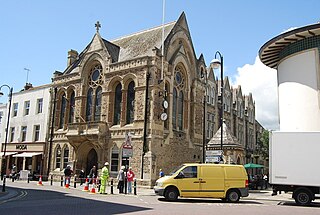
Ripley is a town in the Amber Valley borough of Derbyshire, England.

Alfreton is a town and civil parish in the Amber Valley district of Derbyshire, England. The town was formerly a Norman Manor and later an Urban District. The population of the Alfreton parish was 7,971 at the 2011 Census. The villages of Ironville, Riddings, Somercotes and Swanwick were historically part of the Manor and Urban District, and the population including these was 24,476 in 2001.

Glossop Town Hall, Market Hall, and Municipal Buildings is a complex in the centre of Glossop, Derbyshire, providing offices for High Peak Borough Council, a retail arcade, and covered market. The Town Hall was constructed in 1838 and significantly extended and altered in 1845, 1897 and 1923. The Town Hall building was designed by Weightman and Hadfield of Sheffield for the 12th Duke of Norfolk. It is constructed from millstone grit ashlar and topped with a distinctive circular cupola and clock. It is Grade II listed, forming a group with the market and Municipal Buildings to the south, and rows of shops to High Street West either side which were also part of Hadfield's design, and which marked the transition of Howard Town from a satellite industrial village to a freestanding urban entity.

Berkhamsted Town Hall is a municipal building in the High Street, Berkhamsted, Hertfordshire, England. It is a Grade II listed building.

Maidstone Town Hall is a municipal building in Middle Row, Maidstone, Kent, England. The town hall, which is a meeting place of Maidstone Borough Council, is a Grade II* listed building.

Dukinfield Town Hall is a municipal building in King Street, Dukinfield, Greater Manchester, England. The town hall, which was the headquarters of Dukinfield Borough Council, is a grade II listed building.

Heanor Town Hall is a municipal building in the Market Street, Heanor, Derbyshire, England. The town hall, which is the meeting place of Heanor and Loscoe Town Council, is a grade II listed building.

The Old Town Hall is a municipal building in the High Street, Hemel Hempstead, Hertfordshire, England. The town hall, which was the meeting place of Hemel Hempstead Borough Council, is a Grade II listed building.

Hastings Town Hall is a municipal building in Queen's Road, Hastings, East Sussex, England. The town hall, which was the meeting place of Hastings Borough Council, is a Grade II listed building.

Aylesbury Town Hall is a name which has been used for two different buildings in Aylesbury, Buckinghamshire, England. Since 2007 the name has been used for an office building at 5 Church Street, which serves as the headquarters of Aylesbury Town Council. The name was also formerly used for a complex of buildings which had been built in 1865 as a corn exchange in Market Square, and which served as the offices and meeting place of the local council from 1901 to 1968. The majority of the old town hall was demolished shortly afterwards, leaving only the entrance archway facing Market Square still standing, now called Town Hall Arches. This remaining part of the old town hall is a Grade II* listed building as part of the range of civic buildings on the southern side of Market Square including the old County Hall.

Dudley Council House is a municipal building in Priory Road, Dudley, West Midlands, England. The Council House, which is the meeting place of Dudley Metropolitan Borough Council is a Grade II listed building.

Altrincham Town Hall is a municipal building in Market Street, Altrincham, Greater Manchester, England. The town hall was the headquarters of Altrincham Borough Council.

Farnham Town Hall is a municipal building in South Street, Farnham, Surrey, England. It provides the offices and the meeting place of Farnham Town Council.

Oswestry Guildhall is a municipal building in Bailey Head in Oswestry, Shropshire, England. The structure, which was the meeting place of Oswestry Municipal Borough Council, is a Grade II listed building.

Sandbach Town Hall is a municipal building in the High Street in Sandbach, Cheshire, England. The structure, which is the meeting place of Sandbach Town Council, is a Grade II listed building.

The Old Town Hall, sometimes referred to as the Moot Hall, is a municipal building in Church Street, Clitheroe, Lancashire, England. The structure, which was the meeting place of Clitheroe Borough Council, is a Grade II listed building.

Blandford Forum Town Hall is a municipal building in the Market Place in Blandford Forum, Dorset, England. The 18th-century structure, which was the meeting place of Blandford Forum Borough Council, is a Grade I listed building.

Tring Market House is a municipal building in the High Street, Tring, Hertfordshire, England. The structure, which is the meeting place of Tring Town Council, is a Grade II listed building.

Long Eaton Town Hall is a municipal building in Derby Road, Long Eaton, Derbyshire, England. The town hall, which currently serves as one of two meeting places of Erewash Borough Council, is a Grade II* listed building.

Ashbourne Town Hall is a municipal building in the Market Place, Ashbourne, Derbyshire, England. The town hall, which is the meeting place of Ashbourne Town Council, is a Grade II listed building.





















